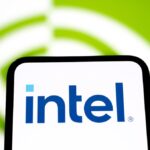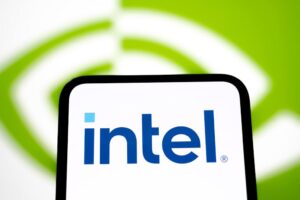This will mark only the 53rd change for Wall Street’s iconic index since its inception on May 26, 1896.
For more than 128 years, the iconic Dow Jones Industrial Average (^DJI -0.61%) has served as a barometer of Wall Street’s health. Over that time, it’s evolved from an index that contained a dozen (mostly) industrial stocks to one that now houses 30 diverse, multinational businesses.
Since its official inception on May 26, 1896, the Dow Jones has seen no shortage of changes. Excluding mergers of existing Dow components and simple name changes, there have been 52 separate instances where companies were added or subtracted, the latest of which involved the removal of pharmacy chain Walgreens Boots Alliance in favor of e-commerce colossus Amazon near the end of February.
Before the opening bell tolls on Friday, Nov. 8, we’ll witness the 53rd change in its storied history.

Image source: Getty Images.
Welcome Nvidia! C’est la vie, Intel!
The most eye-popping change of all, which was announced after the closing bell on Nov. 1, is that leading artificial intelligence (AI) stock Nvidia (NVDA 0.48%) will be joining the Dow, while stalwart semiconductor stock Intel (INTC -2.93%), which has been part of the Dow since November 1999, will be shown the door.
Nvidia completed a historic 10-for-1 forward stock split in June, which is what makes this addition to the Dow Jones possible. Without this split, Nvidia’s stock would be trading above $1,300 per share, which wouldn’t have worked with the ageless index’s share price-based formula.
There’s no question that Nvidia’s AI ties are what have made this move possible. Orders for the company’s H100 graphics processing unit (GPU) and successor GPU architecture, known as Blackwell, are backlogged, which has led to exceptional pricing power that’s meaningfully increased Nvidia’s gross margin.
Nvidia has received a healthy boost from its CUDA software platform, as well. CUDA is the toolkit developers use to maximize the potential of their Nvidia AI-GPUs. Though hardware sales are in the spotlight, CUDA is playing a key role in keeping the company’s clients loyal to its ecosystem of solutions.
The one concern with this addition is that every next-big-thing trend for the last 30 years has endured a bubble-bursting event early in its existence. With artificial intelligence far from a mature technology, it suggests Nvidia, and now the Dow Jones Industrial Average, are at risk if the AI bubble bursts.
Meanwhile, Intel fell behind on the innovation front, and it’s paying the price. It has a daunting task ahead given that Nvidia has a seemingly insurmountable lead in data center GPU market share.
Furthermore, Intel’s vision of becoming the world’s second-largest foundry services provider by the turn of the decade is a costly one. Building the infrastructure needed to make this happen has resulted in some unsightly losses for the former kingpin of the semiconductor industry.
On the bright side, Intel remains the clear market share leader in central processing units (CPUs) for personal computers (PCs) — but even here it’s seen some of its leading share erode thanks to the efforts of Advanced Micro Devices.
While Intel does have a path to effect a turnaround, it’s likely to be a multiyear project. S&P Dow Jones Indices, which is responsible for making the decisions to add or remove Dow components, apparently wasn’t willing to wait for that to happen.
Hello, Sherwin-Williams! See yourself out, Dow, Inc.!
In addition to swapping semiconductor stocks, S&P Dow Jones Indices will be adding materials behemoth Sherwin-Williams (SHW 4.59%) to the iconic index and sending material science solutions company Dow Inc. (DOW -2.08%) to the chopping block after the close of trading on Nov. 7.
Sherwin-Williams is best-known for its long list of painting and coating products, which it sells to residential, commercial, and industrial clients. Although its namesake brand is the face of the company, it also owns the Valspar, Thompson’s WaterSeal, and Krylon brands, among others.
Materials companies tend to be highly cyclical, and Sherwin-Williams is no exception. While it would be expected to see demand wane during an economic downturn, the company benefits from the non-linearity of the economic cycle. Whereas most recessions are resolved in less than a year, the typical economic expansion endures for multiple years. This leads to a steady increase in demand for the company’s products and boosts its pricing power over time.
Further, Sherwin-Williams’s management team hasn’t been afraid to lean on acquisitions as a way to expand its reach and bolster its bottom line. A steady diet of bolt-on acquisitions, as well as the occasional big bite (e.g., buying Valspar for $11.3 billion in 2017), has fueled global expansion and broadened its product portfolio.
Meanwhile, the departing Dow Inc. is the smallest component in the Dow Jones Industrial Average, with a market cap of $34 billion (for context, Sherwin-Williams is a $90 billion company).
In August 2017, then-longtime Dow component DuPont merged with Dow Chemical to form DowDuPont, a holding company that was focused on material sciences, specialty chemicals/products, and agriculture. But in 2019, DowDuPont split into three separate businesses: DuPont, Corteva, and Dow Inc., the latter of which remained in the Dow Jones Industrial Average. With only a third of its previous relevance, it was simply a matter of time before a suitable replacement was found for Dow Inc. in the ageless index.
To add fuel to the fire, Sherwin-Williams has handily outperformed Dow Inc. since DowDuPont split into three separate companies. While Dow Inc. has lost 2% of its value, not including its robust annual dividend yield of almost 6%, since this split, Sherwin-Williams has skyrocketed by 150% (also not including its dividend). It’s not uncommon for S&P Dow Jones Indices to boot components that fail to lift the Dow Jones.

Image source: Getty Images.
Share price matters in the Dow Jones Industrial Average
Aside from companies entering and exiting the Dow prior to the commencement of trading on Friday, Nov. 8, the second change set to occur has to do with the Dow’s Divisor.
The benchmark S&P 500 and growth-powered Nasdaq Composite are both market cap-weighted indexes. This is to say that companies with larger market caps exert greater influence on these two indexes.
For instance, if the largest publicly traded company in the world, Apple ($3.37 trillion market cap), rises or falls by 5%, it should have more bearing on the S&P 500 than if the index’s smallest component, Qorvo ($6.8 billion market cap), rises or declines by 5%.
The Dow Jones Industrial Average is a share price-weighted index. In other words, market cap is irrelevant. The only thing that matters and is ultimately responsible for determining whether the index’s point value climbs or falls is the aggregate share price of its 30 components. Since Intel and Dow Inc. had two of the three lowest share prices within the Dow Jones, as of the Nov. 1 close, their influence was minimal.
The incoming components, Nvidia and Sherwin-Williams, will slot in as the 22nd and sixth most-influential companies within the Dow, based on their respective share prices on Nov. 1.
But in order to account for the sizable share price differences between Nvidia/Intel and Sherwin-Williams/Dow Inc., S&P Dow Jones Indices will need to adjust the Dow’s Divisor, which is what translates a company’s share price into Dow points.
In just a few days, the ageless Dow Jones Industrial Average will have an entirely new look.
John Mackey, former CEO of Whole Foods Market, an Amazon subsidiary, is a member of The Motley Fool’s board of directors. Sean Williams has positions in Amazon, Intel, and Walgreens Boots Alliance. The Motley Fool has positions in and recommends Advanced Micro Devices, Amazon, Apple, and Nvidia. The Motley Fool recommends Intel, Qorvo, and Sherwin-Williams and recommends the following options: short November 2024 $24 calls on Intel. The Motley Fool has a disclosure policy.









